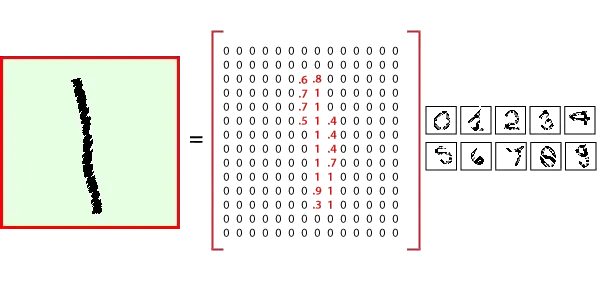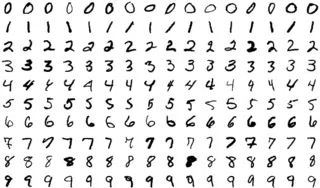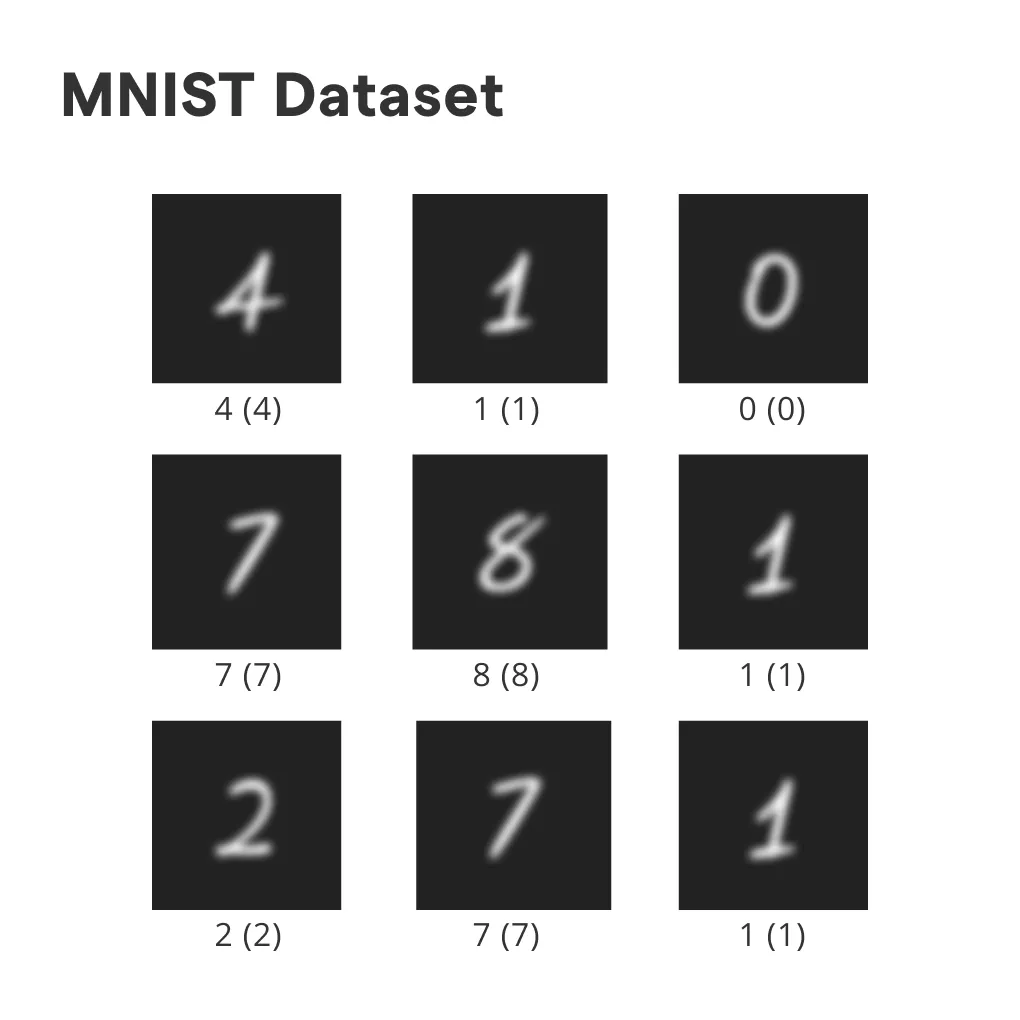What is the MNIST Dataset?
The Modified National Institute of Standards and Technology (MNIST) dataset is a large dataset of handwritten digits. Created by Yann LeCun, Corinna Cortes, and Chris Burges, it has been widely used in machine learning and computer vision.
Content
It consists of 70,000 28x28 pixel grayscale images of hand-drawn digits, from 0 to 9, equally distributed. 60k images form the training set and 10k images form the testing set.
Format
Each image is represented as a matrix, each cell containing a pixel intensity value from 0 (white) to 255 (black). These are then flattened into a 1D array of 784 elements.
Dataset Source
The images were collected from various sources including Census Bureau employees and high school students.
Why it’s important
As a simple-to-understand, yet sophisticated enough dataset, it has become a de facto benchmark for machine learning algorithms, especially in image recognition tasks.
Why is the MNIST Dataset used?
Now that we know the definition of the MNIST Dataset, let's explore the reasons behind its extensive use.
Benchmarking
The MNIST is extensively used for benchmarking machine learning algorithms. It serves as a fair platform due to its moderate complexity and variety.
Machine Learning Education
The dataset is also used in educational settings because of the simplicity of data points and ease of visualization.
Ease of Use
Due to the provided training and testing splits, along with appropriate labelings, this dataset is favored by professionals for its ease of use.
Performance Evaluation
It allows researchers and developers to evaluate and compare the performance of algorithms in the same conditions.
Promoting Machine Learning Research
Being publicly available and widely adopted, it stimulates the development of new algorithms and techniques.
How does the MNIST Dataset work?
Having understood the purpose of the MNIST Dataset, let's get into a deeper understanding of its working.
Data Preparation
The images in the dataset are binarized, normalized, and centered to remove unnecessary noise and variations.
Using the Dataset
The dataset is typically divided into training and testing sets. The training set is used to train the model, while the testing set helps in evaluating its performance.
Machine Learning Tasks
Machine learning algorithms, such as neural networks or support vector machines, are used to classify the images into their respective categories (0-9).
Results Interpretation
The performance of the algorithm is then evaluated based on metrics like accuracy, precision, recall, and F1 score.
Model Tuning
Based on the results, the algorithms' parameters are tweaked for improvements in their performance.
Where is the MNIST Dataset used?
We’ve established a solid understanding of how the MNIST Dataset works, now let's look at its various applications.

Supervised Machine Learning
The MNIST dataset is a classic example for supervised learning tasks, like classification, where the labels are already known.
Image Recognition
The dataset is well-regarded in the field of computer vision for developing and testing image recognition algorithms.
Deep Learning
The dataset has been used in developing deeper network architectures, such as Convolutional Neural Networks (CNN) and Recurrent Neural Networks (RNN).
Benchmarking Machine Learning Models
The MNIST dataset is a common benchmark for a wide range of machine learning models, which provides a standard basis for comparison.
Education and Research
Due to its simplicity and popularity, it is often used in academic settings for teaching machine learning concepts.
When is the MNIST Dataset used?
The next logical step is to comprehend when it's right to use the MNIST Dataset.
Introducing Machine Learning Techniques
The MNIST dataset is used to introduce basic machine-learning techniques and image processing and to benchmark classification algorithms.
Understanding Neural Networks
In the domain of Deep Learning Neural Networks, the MNIST dataset provides an excellent playground to understand the workings of a neural network.
Performance Comparison
When a new algorithm for classification or image recognition is introduced, the MNIST dataset is used to evaluate its performance and compare it against established methods.
Starting Point for Complex Tasks
For more complex image or pattern recognition tasks, the MNIST can serve as a starting point.
Research and Development
It is also a helpful tool for research and development purposes, providing foundational knowledge and serving as a basic step before diving into more complex solvable problems.
MNIST Dataset: Challenges
While the MNIST Dataset has its merits, it also has certain challenges that need to be addressed.

Lack of Complexity
Given its simplicity, algorithms that perform well on MNIST might fail on more complex datasets. This disparity may create false perception of an algorithm's efficacy.
Limited Scope for Innovation
Today, state-of-the-art algorithms can achieve near-perfect accuracy on the MNIST, limiting its capacity to drive forward innovative solutions in the field.
Data Imbalance
The MNIST dataset is relatively balanced in terms of classes. However, this might not represent the real world, where datasets are often imbalanced.
Overfitting Risk
Models could be overfit on the MNIST due to its frequent usage and this could lead to models performing poorly with real-world data.
Dependence on Pre-processing
The success of an algorithm on MNIST often heavily depends on the pre-processing steps, rather than the algorithm's efficacy.
MNIST Dataset: Best Practices
Despite the challenges, the MNIST dataset can be effectively used by following certain best practices.
Proper Splitting
Ensure the dataset is properly divided into training and validation sets, following standard practices, to avoid evaluation bias.
Use as a Learning Tool
Rather than using MNIST as the final benchmark, use it as an educational tool to understand machine learning concepts.
Avoid Overfitting
Ensure your model isn't overfitting by evaluating it on various other datasets aside MNIST.
Pre-processing
Carefully select pre-processing techniques to achieve the best outcomes. It should be done to enhance the learning process, rather than to artificially inflate accuracy.
Keep Up-to-date
Stay informed about the latest advancements in the field to leverage new techniques and improve your algorithms.
MNIST Dataset: Trends
Lastly, we look at rising trends related to the MNIST Dataset.

Use in Deep Learning
With deep learning gaining prominence, the dataset is extensively used for developing sophisticated architectures before they are applied on more complex datasets.
Benchmark for Newly Developed Algorithms
Whenever new image recognition or classification algorithms are developed, they are typically benchmarked against the MNIST dataset.
Released Variants
Variants such as Fashion-MNIST, Kuzushiji-MNIST, and others have been released to provide a richer, more representative variety of tasks.
Growing Emphasis on Real-world Data
There's a growing trend to move beyond MNIST to more realistic and challenging datasets, however, MNIST remains extensively used.
Research in Better Techniques
Despite reaching near-perfect accuracies, research is still being conducted to improve techniques, showcasing the continued relevance of MNIST.
Frequently Asked Questions (FAQs)
What makes the mnist dataset unique in machine learning?
The MNIST dataset is a large collection of handwritten digits, renowned for its simplicity and use as a benchmark in training and testing image processing systems.
why is the mnist dataset widely used by beginners?
Its straightforward format and comprehensibility make MNIST an excellent starting point for beginners to explore and experiment with machine learning techniques.
how does the mnist dataset benefit deep learning research?
MNIST has been pivotal in deep learning research, serving as a common ground for evaluating the performance of new algorithms, especially in image classification.
What are the components of the mnist dataset?
The MNIST dataset comprises 60,000 training images and 10,000 testing images of handwritten digits, each standardized in size and centered in a fixed-size image.
How has the mnist dataset influenced further developments in machine learning?
It's been a catalyst for advancements in machine learning and computer vision, inspiring the creation of more complex datasets to tackle a wider range of challenges.

